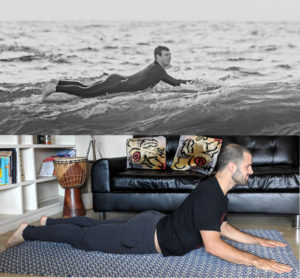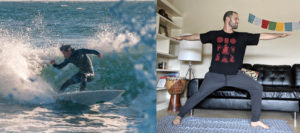
It was a perfect day for wave-sliding in sunny Southern California: a head-high southwest swell, almost no wind and a wide open schedule. ‘Squatting Yoda’ crouched down underneath the barrel as his board slid along the surface of the ocean. With nowhere to be, the only thing on his to-do list was paddling out, waiting for the right wave, catching it, and riding it back in — rinse and repeat — until the sun set over the horizon.
For a few lucky surfers, these conditions may be all that is needed to sustain the joys of regular surfing. For some, however, a surf session can take quite a toll on the body. I recently checked in with my surfer friends Stormin’ Normin, Mitch, Squatting Yoda, Howie, Lish, Os, Kip and Pablo, to find out more about their common aches and pains. I learned that pain or fatigue can, unfortunately, cause tasty waves to be sacrificed for the sake of rest and recovery.
Surfing can be an incredibly potent act of self-care, both mentally and physically, but also has the potential to create a slew of bodily issues. Musculoskeletal pain, strain and imbalances are especially common in the ankles, shoulders, knees and lower back. Which makes a lot of sense given my own ill-fated surfing experience.
When Surf’s Up but the Body’s Breaking Down
Technically, I have surfed: over the years I’ve had a few experiences paddling out on a surfboard while on a warm sunny beach in Hawaii or Mexico. I sat out in the water, waited for waves, and sort of rode them, although never well. Then while attending college in Santa Barbara, I lived just minutes from the beach. So I tried hopping on the bandwagon as my friends quickly made surfing one of their go-to pastimes.
Unfortunately however, dormant old injuries from high school resurfaced aggressively when I got out in the water on a board, and I quickly decided that not only was the activity too uncomfortable to keep pursuing, but it seemed like it was making these pain points worse.
My body spoke and I listened. Surfing, at that point in my life, was a no-go.

So I turned my time and energy to yoga, which served my needs in many of the same ways that surfing served my friends’ needs: providing a meditative experience, a workout and a sense of community. The difference for me was that yoga soothed my chronic pains, rather than aggravating them. I soon became a yoga teacher myself.
Then as time went on, I began to see just how similar (and complementary) yoga and surfing could be. It’s no wonder that many surfers use yoga as cross-training for their surf practice. The strength, mobility and balance developed in yoga directly translate to movements on their surfboards.
Striking Similarities Between Yoga Poses and Surfing
From a movement perspective, the most frequent motion of surfing — paddling out — looks awfully similar to certain backbends performed on the floor during yoga, such as locust and cobra pose.

Meanwhile, the Warrior poses in yoga practice mirror the posture of a surfer riding a wave.

When I furthered my education in fitness therapy by becoming a Tune Up Fitness instructor, I found even more customized ways to help my surfer friends. By tailoring specific corrective exercise and self-massage techniques to their unique surfing pain points, I’ve been able to help them do what they love — spend more of those long, peaceful days gliding on the surface of the ocean.
In my next post I will share specific exercises to help with the top two physical pains that my surfer friends suffer from the most. Be sure to tune in next week!










I never realized how similar the yoga poses and surf shapes are! I wonder what effect the use of the coregeous ball on the trunk would have for surfers. I imagine the thrill of the sport puts the nervous system in an alert state, because of the unpredictability and potential danger. Down regulating with the coregeous on the lumbar (thoracolumbar fascia) with rotation and sheer with longer exhalation breathing could be an interesting start.
I’ve just started my surfing journey this year with a couple of private lessons in Santa Cruz, CA. With my background in yoga, backpacking, running, soccer, and dance, the dynamic experience of catching waves have been AMAZING.
While I’m thankful to not be impacted by previous injury aggravation, I’ve certainly felt very sore, and getting tossed around in the waves is pretty hard on the body.
I’m interested in continuing to get out in the waves and experience more of the profound joy that being in the ocean brings.
I have a long ways to go in learning the best post-recovery, and am inspired to explore more of where the surf and yoga communities overlap 🙂
Me gusta ir a hacer surf a punta mita en México cada verano, las olas son de buen tamaño y la energia que se requiere cobre la tabla es mucha, considero importante hacer Yoga Vinyasa cómo calentamiento previo al surf, el cual incluye saludos al sol clasicos, A y B donde puedes ejercitar el Psoas y los musculos de pierna cómo cuadrado femoral, isquiotivial menor y mayor, la parte media del cuerpo desde el ilipsoas con el cuadrado abdominal hasta la columna cómo son romboides, escapulas y deltoides.
It is always amazing to see how yoga movements can connect to virtually every activity you can think of. I loved seeing the comparisons to cobra/paddling out and warrior 2/standing on a surfboard. I am in the process of moving to Florida and plan to do some surfing, so this was extra exciting to read!
Totally agree!
I actully haven’t really met a surfer who isn’t into yoga , so your on point !!
I agree! I tried surfing in Costa Rica a few years ago and summoned my inner yogi to find balance and position on the board.
I enjoyed reading of another sport applying the concepts of yoga. Great use of the photos.
I really enjoy this post. I like this side by side picture really puts things into perspective. Never looked at surfing from a yogi stand point.
Amazing to put pics side by side, positions er definitely very similar! How about Savasana on the beach once you get out of water? ;-))
Fun to see your name and read your article. I heard that you were a yoga teacher, but didn’t know you did tune up…so great for all bodies and all ages! tell your mom I said hi from Moraga:) .
Thank you for sharing these pictures! Now I understand much more the parallels of yoga poses and surfing.
Reading your article, I realize that so many activities can be enhanced by a well-rounded practice of yoga. I used to focus a lot on the back when talking about postureto my students, but the YTU teacher training has given me a richer perspective on all the day-to-day applications of the practice, in area of the body that I have neglected, I must admit. Thanks for sharing your exploration!
Thank you for your blog post! This is great to hear. My husband surfs and he’s a happy person because of it! I would love him to do more yoga to help his body so he can continue to surf for a long time! I love how you described bridging yoga with surfing (and I thought of more poses too!) and since your article he is more interested in yoga. He practices cobra and warrior 2 and I showed him “Sitting Seva with a strap” to strengthen his ankles and ball of his big toe since his feet sometimes ache after surfing. Thank you for sharing!